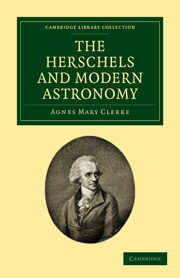Book contents
- Frontmatter
- PREFACE
- Contents
- ILLUSTRATIONS
- CHAPTER I EARLY LIFE OF WILLIAM HERSCHEL
- CHAPTER II THE KING'S ASTRONOMER
- CHAPTER III THE EXPLORER OF THE HEAVENS
- CHAPTER IV HERSCHEL'S SPECIAL INVESTIGATIONS
- CHAPTER V THE INFLUENCE OF HERSCHEL'S CAREER ON MODERN ASTRONOMY
- CHAPTER VI CAROLINE HERSCHEL
- CHAPTER VII SIR JOHN HERSCHEL AT CAMBRIDGE AND SLOUGH
- CHAPTER VIII EXPEDITION TO THE CAPE
- CHAPTER IX LIFE AT COLLINGWOOD
- CHAPTER X WRITINGS AND EXPERIMENTAL INVESTIGATIONS
- INDEX
- Plate section
CHAPTER X - WRITINGS AND EXPERIMENTAL INVESTIGATIONS
Published online by Cambridge University Press: 05 October 2010
- Frontmatter
- PREFACE
- Contents
- ILLUSTRATIONS
- CHAPTER I EARLY LIFE OF WILLIAM HERSCHEL
- CHAPTER II THE KING'S ASTRONOMER
- CHAPTER III THE EXPLORER OF THE HEAVENS
- CHAPTER IV HERSCHEL'S SPECIAL INVESTIGATIONS
- CHAPTER V THE INFLUENCE OF HERSCHEL'S CAREER ON MODERN ASTRONOMY
- CHAPTER VI CAROLINE HERSCHEL
- CHAPTER VII SIR JOHN HERSCHEL AT CAMBRIDGE AND SLOUGH
- CHAPTER VIII EXPEDITION TO THE CAPE
- CHAPTER IX LIFE AT COLLINGWOOD
- CHAPTER X WRITINGS AND EXPERIMENTAL INVESTIGATIONS
- INDEX
- Plate section
Summary
Could the whole of Sir John Herschel's astronomical career be obliterated, and the whole of his contributions to pure mathematics be forgotten, he would still merit celebrity as a physicist. Experimental optics, above all, engaged his attention. “Light,” he himself said, “was his first love,” and he was never wholly forgetful of it. In 1830 he described himself as “forcibly drawn aside from his optical studies” by the claims of nebulae and double stars. How strong he felt those claims to be, can best be understood by considering the firmness with which he averted his mind, out of regard to them, from the intricate and bewitching subject of his early devotion.
“In understand from Peacock,” Dr. Whewell wrote to him, June 19, 1818, “that you are untwisting light like whipcord, examining every ray that passes within half a mile, and putting the awful question, ‘Polarised, or not polarised?’ to thousands that were never before suspected of any intention but that of moving in a straight line.” These interrogatories brought out a remarkable diversity in the action upon light of quartz, and other similar substances, corresponding with the two different modes of crystallisation belonging to each of them. Here, in Lord Kelvin's phrase, is “one of the most notable meeting-places between natural history and natural philosophy.”
- Type
- Chapter
- Information
- The Herschels and Modern Astronomy , pp. 203 - 220Publisher: Cambridge University PressPrint publication year: 2010First published in: 1895



